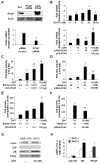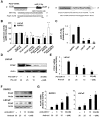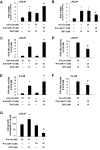miR-17-5p targets the p300/CBP-associated factor and modulates androgen receptor transcriptional activity in cultured prostate cancer cells
- PMID: 23095762
- PMCID: PMC3519561
- DOI: 10.1186/1471-2407-12-492
miR-17-5p targets the p300/CBP-associated factor and modulates androgen receptor transcriptional activity in cultured prostate cancer cells
Abstract
Background: Androgen receptor (AR) signalling is critical to the initiation and progression of prostate cancer (PCa). Transcriptional activity of AR involves chromatin recruitment of co-activators, including the p300/CBP-associated factor (PCAF). Distinct miRNA expression profiles have been identified in PCa cells during the development and progression of the disease. Whether miRNAs regulate PCAF expression in PCa cells to regulate AR transcriptional activity is still unclear.
Methods: Expression of PCAF was investigated in several PCa cell lines by qRT-PCR, Western blot, and immunocytochemistry. The effects of PCAF expression on AR-regulated transcriptional activity and cell growth in PCa cells were determined by chromatin immunoprecipitation, reporter gene construct analysis, and MTS assay. Targeting of PCAF by miR-17-5p was evaluated using the luciferase reporter assay.
Results: PCAF was upregulated in several PCa cell lines. Upregulation of PCAF promoted AR transcriptional activation and cell growth in cultured PCa cells. Expression of PCAF in PCa cells was associated with the downregulation of miR-17-5p. Targeting of the 3'-untranslated region of PCAF mRNA by miR-17-5p caused translational suppression and RNA degradation, and, consequently, modulation of AR transcriptional activity in PCa cells.
Conclusions: PCAF is upregulated in cultured PCa cells, and upregulation of PCAF is associated with the downregulation of miR-17-5p. Targeting of PCAF by miR-17-5p modulates AR transcriptional activity and cell growth in cultured PCa cells.
Figures




Similar articles
-
Phenethyl isothiocyanate inhibits androgen receptor-regulated transcriptional activity in prostate cancer cells through suppressing PCAF.Mol Nutr Food Res. 2013 Oct;57(10):1825-33. doi: 10.1002/mnfr.201200810. Epub 2013 May 10. Mol Nutr Food Res. 2013. PMID: 23661605
-
miR-141 modulates androgen receptor transcriptional activity in human prostate cancer cells through targeting the small heterodimer partner protein.Prostate. 2012 Oct 1;72(14):1514-22. doi: 10.1002/pros.22501. Epub 2012 Feb 7. Prostate. 2012. PMID: 22314666
-
Identification of miR-30b-3p and miR-30d-5p as direct regulators of androgen receptor signaling in prostate cancer by complementary functional microRNA library screening.Oncotarget. 2016 Nov 8;7(45):72593-72607. doi: 10.18632/oncotarget.12241. Oncotarget. 2016. PMID: 27683042 Free PMC article.
-
The transcriptional regulation of miR-21, its multiple transcripts, and their implication in prostate cancer.Cell Cycle. 2010 Mar 1;9(5):923-9. doi: 10.4161/cc.9.5.10930. Epub 2010 Mar 11. Cell Cycle. 2010. PMID: 20160498 Free PMC article. Review.
-
Lysine Acetyltransferases and Their Role in AR Signaling and Prostate Cancer.Front Endocrinol (Lausanne). 2022 Aug 17;13:886594. doi: 10.3389/fendo.2022.886594. eCollection 2022. Front Endocrinol (Lausanne). 2022. PMID: 36060957 Free PMC article. Review.
Cited by
-
Loss of RBMS1 as a regulatory target of miR-106b influences cell growth, gap closing and colony forming in prostate carcinoma.Sci Rep. 2020 Oct 22;10(1):18022. doi: 10.1038/s41598-020-75083-9. Sci Rep. 2020. PMID: 33093529 Free PMC article.
-
In Silico Study of miRNA Based Gene Regulation, Involved in Solid Cancer, by the Assistance of Argonaute Protein.Genomics Inform. 2016 Sep;14(3):112-124. doi: 10.5808/GI.2016.14.3.112. Epub 2016 Sep 30. Genomics Inform. 2016. PMID: 27729841 Free PMC article.
-
Overexpression of miR-17 predicts adverse prognosis and disease recurrence for acute myeloid leukemia.Int J Clin Oncol. 2022 Jul;27(7):1222-1232. doi: 10.1007/s10147-022-02161-5. Epub 2022 May 10. Int J Clin Oncol. 2022. PMID: 35536524 Free PMC article.
-
miR-17 as a diagnostic biomarker regulates cell proliferation in breast cancer.Onco Targets Ther. 2017 Jan 27;10:543-550. doi: 10.2147/OTT.S127723. eCollection 2017. Onco Targets Ther. 2017. PMID: 28203087 Free PMC article.
-
The other face of miR-17-92a cluster, exhibiting tumor suppressor effects in prostate cancer.Oncotarget. 2016 Nov 8;7(45):73739-73753. doi: 10.18632/oncotarget.12061. Oncotarget. 2016. PMID: 27650539 Free PMC article.
References
-
- Lamont KR, Tindall DJ. Androgen regulation of gene expression. Adv Cancer Res. 2010;107:137–162. - PubMed
Publication types
MeSH terms
Substances
LinkOut - more resources
Full Text Sources
Molecular Biology Databases
Research Materials
Miscellaneous

